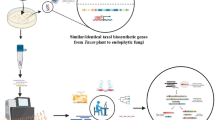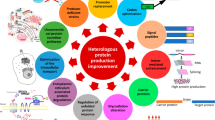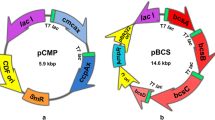Abstract
Endoglucanase is a major cellulolytic enzyme produced by the fungus Trichoderma viride. The 1,317 bp cDNA of endoglucanase gene egVIII was cloned from T. viride AS3.3711, encoding a 438 amino acid protein with a calculated molecular mass of 46.86 kDa and isoelectric point of 4.32. Sequence analysis suggested that EGVIII belonged to the glycosyl hydrolase family 5. The N-terminal region of EGVIII contains a signal peptide sequence of 19 amino acid residues, indicating that it is an extracellular enzyme. Transcription of the egVIII gene in T. viride AS3.3711 can be induced by carboxymethyl cellulose sodium (CMC-Na), sucrose, microcrystalline cellulose, and corn stalk, and inhibited by glucose and fructose. The α-mating factor signal can effectively enhance the secretion of the recombinant EGVIII in Saccharomyces cerevisiae, as demonstrated by the enzymatic activity of recombinant yeast IpYEMα-xegVIII in the supernatant, which was 0.86 times higher than that of the IpYES2-egVIII. Recombinant endoglucanase EGVIII showed optimal activity at a temperature of 60°C and pH of 6.0. It was stable when incubated from 35°C to 70°C for 1 h. The enzymatic activity of recombinant EGVIII was stable at a pH 3.0 to 7.5 at 50°C and reached the highest level at 0.174U when activated by 75 mM of Zn2+. The Michaelis–Menten constant (Km) and Kcat values for CMC-Na and cellotriose hydrolysis were 3.82 mg/ml, 9.56 s−1 and 1.75 mg/ml, 7.08 s−1, respectively. Transgenic yeast strain IpYEMα-xegVIII might be useful for renewable fuels industries.






Similar content being viewed by others
References
Wyman, C. E. (2003). Biotechnology Progress, 19, 254–262. doi:10.1021/bp025654l.
Green, N., Celik, E.F., Dale, B., Jachson, M., Jayawardhana, K., Jin, H., et al. (2004). Natural Resources Defense Council, 12. http://www.nrdc.org/air/energy/biofuels/biofuels.pdf.
Qin, Y. Q., Wei, X. M., Liu, X. M., Wang, T. H., & Qu, Y. B. (2008). Protein Expression and Purification, 58, 162–167. doi:10.1016/j.pep.2007.09.004.
Saloheimo, M., Nakari-setala, T., Tenkanen, M., & Enkanen, M. (1997). European Journal of Biochemistry, 24, 584–591. doi:10.1111/j.1432-1033.1997.00584.x.
Van Arsdell, J. N., Kwok, S., Schweickart, V. L., Ladner, M. B., Gelfand, D. H., & Innis, M. A. (1987). Biotechnology, 5, 60–64. doi:10.1038/nbt0187-60.
Ekino, K. K., Goto, M., & Furukawa, K. (1999). Bioscience, Biotechnology, and Biochemistry, 63, 1714–1720. doi:10.1271/bbb.63.1714.
Yao, Q., Sun, T. T., Chen, G. J., & Liu, W. F. (2007). Biotechnology Letters, 29, 1243–1247. doi:10.1007/s10529-007-9379-5.
Parvez, S., Rajoka, M. I., Fariha, F., & Malik, K. A. (1994). Folia microbiologica, 39, 251–254. doi:10.1007/BF02814307.
Penttilä, M. E., André, L., Lehtovaara, P., Bailey, M., Teeri, T. T., & Knowles, J. K. (1988). Gene, 63, 103–112. doi:10.1016/0378-1119(88)90549-5.
Takada, G., Kawaguchi, T., Sumitani, J., & Arai, M. (1998). Bioscience, Biotechnology, and Biochemistry, 62, 1615–1618. doi:10.1271/bbb.62.1615.
Zhang, X. Z., Yan, X., Cui, Z. L., & Lee, S. P. (2006). ACTA Microbiologica Sinica, 46, 526–530.
Adams, A., Gottschling, D. E., Kaiser, C. A., & Stearns, T. (1997). Methods in yeast genetics: a cold spring harbor course manual (pp. 139–159). Cold Spring Harbor, NY: Cold Spring Harbor Press.
Wei, Q. (1999). The guide of molecular biology experiment (pp. 12–25). Harbin: Higher Education Press.
Thomson, J., Gibons, T., Plewniak, F., Jeanmougin, F., & Higgins, D. (1997). Nucleic Acids Research, 24, 4876–4882. http://nar.oxfordjournals.org/cgi/content/full/25/24/4876.
Van Wyk, J. P. H., & Mohulatsi, M. (2003). Bioresource Technology, 86, 21–23. doi:10.1016/S0960-8524(02)00130-X.
Krautwurst, H., Bazaes, S., González, F. D., Jabalquinto, A. M., Frey, P. A., & Cardemil, E. (1998). Biochemistry, 37, 6295–6302. doi:10.1021/bi971515e.
Meinke, A., Damude, H. G., Tomme, P., Kwan, E., Kilburn, D. G., Miller, R. C., Jr., et al. (1995). Journal of Biological Chemistry, 270, 4383–4386. http://www.jbc.org/cgi/reprint/270/9/4383.
Bradford, M. (1976). Analytical Biochemistry, 72, 248–254.
Coutinho, P. M., & Henrissat, B. (1999). The modular structure of celluloses and other carbohydrate-active enzymes: an integrated database approach. In K. Ohmiya, K. Hayashi, K. Sakka, Y. Kobayashi, S. Karita & T. Kimura (Eds.), Genetics, biochemistry and ecology of cellulose degradation (pp. 15–23). Tokyo: Uni. Publishers.
Udenfriend, S., & Kodukula, K. (1995). Methods in Enzymology, 250, 571–582. doi:10.1016/0076-6879(95)50098-7.
Zhou, J., Wang, Y. H., Chu, J., Zhuang, Y. P., Zhang, S. L., & Yin, P. (2008). Bioresource Technology, 99, 6826–6833. doi:10.1016/j.biortech.2008.01.077.
Cho, K. M., Hong, S. J., Math, R. K., Islam, S. M., Kim, J. O., Lee, Y. H., et al. (2008). Journal of Basic Microbiology, 48, 464–472. doi:10.1002/jobm.200700281.
Tsai, C. F., Qiu, X., & Liu, J. H. (2003). Anaerobe, 9, 131–140. doi:10.1016/S1075-9964(03)00087-8.
Sasvári, Z., Posta, K., & Hornok, L. (2008). Acta Microbiologica et Immunologica Hungarica, 55, 437–446.
Saloheimo, M., Nakari-Setala, T., Tenkanen, M., & Penttila, M. (1997). European Journal of Biochemistry, 249, 584–591. doi:10.1111/j.1432-1033.1997.00584.x.
Foreman, P. K., Brown, D., Dankmeyer, L., Dean, R., Diener, S., Dunn-Coleman, N. S., et al. (2003). Journal of Biological Chemistry, 278, 31988–31997. doi:10.1074/jbc.M304750200.
Saha, B. C. (2004). Process Biochemistry, 39, 1871–1876. doi:10.1016/j.procbio.2003.09.013.
Ding, S. J., Ge, W., & Buswell, J. A. (2002). Enzyme and Microbial Technology, 31, 621–626. doi:10.1016/S0141-0229(02)00168-0.
Li, D. C., Lu, M., Li, Y. L., & Lu, J. (2003). Enzyme and Microbial Technology, 33, 932–937. doi:10.1016/S0141-0229(03)00245-X.
Saad, R. R., & Fawzi, E. M. (2004). New Egypt. Journal of Microbiology, 8, 1–9.
Jabbar, A., Rashid, M. H., Javed, M. R., Perveen, R., & Malana, M. A. (2008). Journal of Industrial Microbiology & Biotechnology, 35, 515–524. doi:10.1007/s10295-008-0310-4.
Saleem, M., Rashid, M. H., Jabbar, A., Perveen, R., Khalid, A. M., & Rajoka, M. I. (2005). Process Biochemistry, 40, 849–855. doi:10.1016/j.procbio.2004.02.026.
Okada, G., & Nisizawa, K. (1975). Journal of Biochemistry (Tokyo), 78, 297–306.
Okada, G. (1976). Journal of Biochemistry (Tokyo), 80, 913–922.
Ricardo, M., Carmen, A., Maria, P. C., Juan, M. D., Isabel, M., Goran, P., et al. (1993). Journal of Biochemistry, 289, 867–873.
Kang, H. A., Nam, S. W., Kwon, K. S., Chung, B. H., & Yu, M. H. (1996). Journal of Biotechnology, 48, 15–24. doi:10.1016/0168-1656(96)01391-0.
Wonganu, B., Pootanakit, K., Boonyapakron, K., Champreda, V., Tanapongpipat, S., & Eurwilaichitr, L. (2008). Protein Expression and Purification, 58, 78–86. doi:10.1016/j.pep.2007.10.022.
Acknowledgements
This research was funded by the projects of the Key Science and Technology Program of Heilongjiang province (GC05C209) and National Key Technology R&D Program of China during the 11th 5-year plan period (2006BAD07A00).
Author information
Authors and Affiliations
Corresponding author
Rights and permissions
About this article
Cite this article
Huang, XM., Yang, Q., Liu, ZH. et al. Cloning and Heterologous Expression of a Novel Endoglucanase Gene egVIII from Trichoderma viride in Saccharomyces cerevisiae . Appl Biochem Biotechnol 162, 103–115 (2010). https://doi.org/10.1007/s12010-009-8700-2
Received:
Accepted:
Published:
Issue Date:
DOI: https://doi.org/10.1007/s12010-009-8700-2




